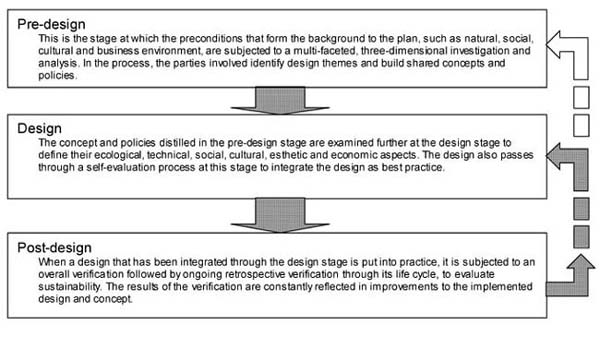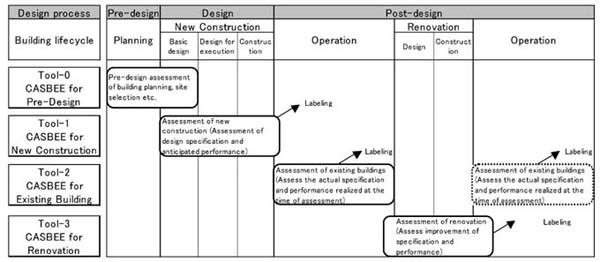|

Measures
to Promote Sustainability
Buildings, which
consume and discard resources and energy in enormous quantities, are
one of architectural category which we must act urgently to develop
and promote techniques and policies able to assist the drive towards
sustainability. There has been a growing movement towards sustainable
construction since the second half of the 1980s, leading to the development
of various methods for evaluating the environmental performance of buildings.
Methods developed overseas include BREEAM (Building Research Establishment
Environmental Assessment Method) in the UK, LEEDTM (Leadership
in Energy and Environment Design) in the USA, and SB Tool (Sustainable
Building Tool) as an international project. These methods have attracted
interest around the world. This kind of assessment, with the publication
of the results, is one of the best methods now available to provide
an incentive for clients, owners, designers and users to develop and
promote highly sustainable construction practices.
CASBEE was developed
according to the following policies:
1) The system should
be structured to award high assessments to superior buildings, thereby
enhancing incentives to designers and others.
2) The assessment system should be as simple as possible.
3) The system should be applicable to buildings in a wide range of building
types.
4) The system should take into consideration issues and problems peculiar
to Japan and Asia.
Framework
of CASBEE: CASBEE Family
Building Lifecycle and Four
Assessment Tools
As shown in figure1,
CASBEE was developed in the suite of architectural design process, starting
from the pre-design stage and continuing through design and post design
stages.

Figure
1. The cyclical process of building design
Corresponding to the building lifecycle, CASBEE is composed of four
assessment tools, CASBEE for Pre-design, CASBEE for New Construction,
CASBEE for Existing Building and CASBEE for Renovation, and to serve
at each stage of the design process (figure 2). CASBEE Family is the
collective name for these four basic tools and the tools for specific
purposes. Each tool is intended for the specific purpose and target
users, and is designed to accommodate a wide range of building types
(offices, schools, apartments, etc.).

Figure
2. Building Lifecycle and Four Assessment Tools
(click the above image for enlarging.)
Four
Basic Tools
CASBEE
for Pre-design (underdevelopment)
This tool aims to assist the owner, planner and others involved at the
planning (pre-design) stage of the project. It has two main roles:
1) To assist in grasping issues such as the basic environmental impact
of the project and selecting a suitable site.
2) To evaluate the environmental performance of the project at the Pre-design
stage.
CASBEE for
New Construction
This is a self-assessment check system that allows architects and engineers
to raise the BEE value of the building under consideration during its
design process. It makes assessments based on the design specification
and the anticipated performance. It can also serve as a labeling tool
when the building is subjected to expert third-party assessment.
CASBEE for
Existing Building
This assessment tool targets existing building stock, based on operation
records for at least one year after completion. It was developed to
be applicable to asset assessment as well.
CASBEE for
Renovation
There is growing demand for building stock renovation, especially in
Japanese market. In the same way as gCASBEE for Existing Building,h
this tool targets existing buildings. It can be used to generate proposals
for building operation monitoring, commissioning and upgrade design
with a view to ESCO (Energy Service Company) projects, which will be
increasingly important in future, and for building stock renovation.
CASBEE
for Specific Purposes
We have also developed
the various versions of CASBEE according to the specific purposes.
(1) For
Detached houses
The CASBEE basic tools are applicable for apartment complexes, but not
detached houses.
CASBEE for Detached Houses was developed for an assessment of detached
houses.
(2)
For Temporary Construction
The tool "CASBEE for Temporary Construction," was developed
as an extension tool of CASBEE for New Construction. It can be applied
for assessment of temporary buildings for short-term use like exhisibition
hall and olimpic facilities.
(3) Brief
versions
Assessment by CASBEE for New Construction may take 3-7 days in case
of including the time to prepare evidence documents and calculate the
related items. The brief versions were developed to meet the growing
needs for tools to handle objectives shown below.
1) The need for
setting goals of the built environment efficiency in the early stage
of building project (as a tool for consensus forming between owners,
designers and builders, etc.).
2) The need for setting management targets of environmental performance
of existing buildings (like a management tool under ISO14001 etc.).
3) The need for establishing the report system by local governments
(like Nagoya city, Osaka city and Yokohama city etc.).
There are 3 brief
versions of the basic tools, CASBEE-NC brief version, CASBEE-EB brief
version and CASBEE-RN brief version. They are simplified and can be
completed the assessment in around couple of hours (excluding time for
the preparation of an Energy Saving Plan). In addition, the brief version
of CASBEE for Urban Development have also been developed.
(4) Local
goverment versions
As noted above, CASBEE is used by some local governments in Japan. The
local governments tailor it to local conditions, such as climate and
prioritized policies. Changes are generally made by modifying the weighting
coefficients. Report of the assessment result to the local goverment
is mandatory in the same way as the Energy Saving Plan and the building
approval application. As of December 2011, 24 local governments have
been introduced the reporting system as their environmental policies.
The details are shown in statistics page.
(5) For
Heat Island Effect
The heat island effect is becoming a critical issue in major urban areas,
such as Tokyo and Osaka. CASBEE-HI (Heat Island) was developed to evaluate
efforts in buildings to alleviate the heat island effect. The role is
to make a more detailed and quantitative assessment of the heat island-related
items of the basic tools.
(6) For
Urban Development
The basic CASBEE tools can evaluate individual buildings, not building
groups. Many recent city-center redevelopment projects have been planned
for integration with their surrounding districts and delivering positive
effects for the environment, like promoting the use of area energy networks.
Even if each individual building has a different owner, taking the common
environmental measures on buildings within a district can raise environment
quality and performance throughout the area. CASBEE for Urban Development
was developed to make broader assessments, adopting holistic approach
delivered through the urban area.
(7) For
Cities
Recenty, people became highly aware of the importance of actions at
the city level for the creation of low carbon societies. Countries and
cities around the world have been implementing a variety of programs
and polices for that purpose. CASBEE for Cities is a system for complehensively
evaluating the environmental performance of cities, using a triple bottom
line approach of "environment", "society" and "economy".
It can objectively assess the effectiveness of the city's policies and
environmental measures.
(8) CASBEE
for Market Promotion
CASBEE for Market Promotion was developed with an intention to be widely
used among property market participants, since conventional CASBEE rating
schemes had been used mainly as tools for “Design for Environment”.
Compared with other CASBEE rating schemes, CASBEE for Market Promotion
is a shorter version covering common metrics examined by UNEP SBCI and
considers alignment with other internationally recognized certification
schemes, e.g., LEED. The target for CASBEE for Market Promotion is existing
buildings, built more than 1 year ago, and the the official certifications
have been awarded since 2013.
Table
1 Expansion of CASBEE for specific purposes (as of April 2014)
| Application |
Name |
| For
Detached Houses |
CASBEE
for Detached Houses
(for New Construction, for Existing Building) |
| For Temporary
Construction |
CASBEE for
Temporary Construction |
| Brief
versions |
CASBEE
for New Construction (Brief Version), for Existing
Buildings (Brief version), for Renovation (Brief version)
CASBEE for Urban Development (Brief version) |
| Local government
versions |
CASBEE-Nagoya,
CASBEE-Osaka, CASBEE-Yokohama etc. |
| For
Heat Island effect |
CASBEE
for Heat Island |
| For
Urban Development |
CASBEE
for Urban Development |
| For Cities |
CASBEE for
Cities |
| For Market Promotion |
CASBEE
for Market Promotion |
Research
and Depelopment Organization
Research and development
of CASBEE is a joint industrial/government/academic project established
under the support of the Japanese ministiry of Land, Insrastructure,
Transport and Tourism. The CASBEE Research Committee and its affiliated
sub-committees established at Japan Sustainable Building Consortium
provide overall project operation as shown in the chart below.
Copyright
(C) Japan GreenBuild Council (JaGBC) / Japan Sustainable Building Consortium
(JSBC),
All Rights Reserved.
|

